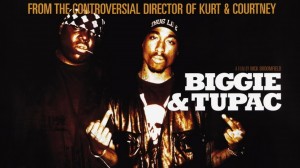BIGGIE AND TUPAC
 Your enjoyment of Biggie and Tupac is directly related to your enjoyment of director Nick Broomfield and his bumbling passive-aggressive approach to ambush journalism. He dominates the movie, integrating himself into the story in his search to uncover the culprits behind the slaying of the Notorious BIG and Tupac Shakur, two of hip hop’s brightest stars, gunned down within months of one another. Six years after the murders no arrests have been made, and while Broomfield offers some possible suspects, he stops short of any definitive conclusion. He suggests several motives for the killings, but the point of the film is to chronicle his investigation – to present the facts and open a new dialogue about the culture of violence that is prevalent in hip hop – rather than pointing the finger at one guilty party. I find Broomfield’s approach highly entertaining, and while he veers off course occasionally – there is a long pointless sequence with an ex-girlfriend of two LAPD officers allegedly tied to Tupac’s murder that hinges on the sex lives of the officers, not their criminal behaviour – you have to admire his bravado in chasing down interviews in backrooms, prison yards, anywhere the story takes him. In the film’s final third there is an interview with Suge Knight, head honcho at Death Row Records, a leading rap label. Knight was in prison at the time, and didn’t want to do the interview, but through sheer persistence Broomfield got him on camera. You can sense the tension in the sequence. The camera is noticeable jittery, as though the camera operator was have an anxiety attack while shooting, and Broomfield is unusually subdued. Knight begins benignly enough with a “message for the kids” which slowly disintegrates into a hate filled diatribe and death threat against rap artist Snoop Dogg. It is powerful footage, and worth the price of admission.
Your enjoyment of Biggie and Tupac is directly related to your enjoyment of director Nick Broomfield and his bumbling passive-aggressive approach to ambush journalism. He dominates the movie, integrating himself into the story in his search to uncover the culprits behind the slaying of the Notorious BIG and Tupac Shakur, two of hip hop’s brightest stars, gunned down within months of one another. Six years after the murders no arrests have been made, and while Broomfield offers some possible suspects, he stops short of any definitive conclusion. He suggests several motives for the killings, but the point of the film is to chronicle his investigation – to present the facts and open a new dialogue about the culture of violence that is prevalent in hip hop – rather than pointing the finger at one guilty party. I find Broomfield’s approach highly entertaining, and while he veers off course occasionally – there is a long pointless sequence with an ex-girlfriend of two LAPD officers allegedly tied to Tupac’s murder that hinges on the sex lives of the officers, not their criminal behaviour – you have to admire his bravado in chasing down interviews in backrooms, prison yards, anywhere the story takes him. In the film’s final third there is an interview with Suge Knight, head honcho at Death Row Records, a leading rap label. Knight was in prison at the time, and didn’t want to do the interview, but through sheer persistence Broomfield got him on camera. You can sense the tension in the sequence. The camera is noticeable jittery, as though the camera operator was have an anxiety attack while shooting, and Broomfield is unusually subdued. Knight begins benignly enough with a “message for the kids” which slowly disintegrates into a hate filled diatribe and death threat against rap artist Snoop Dogg. It is powerful footage, and worth the price of admission.
Leave a Reply
You must be logged in to post a comment.
